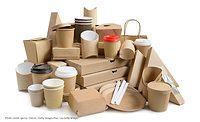Sustainable Packaging: An Opportunity to Stay Competitive in a Post-COVID World
A recent survey explores the trend toward sustainable packaging and possible ramifications for decision makers in the packaging sector.

Image courtesy of paulynn via iStock/Getty Images Plus

The worldwide green packaging market will see strong growth as consumers focus on the impact of their buying decisions.
Image courtesy of vchal via iStock/Getty Images Plus

CPG packaging decision makers are focusing on recyclability and reducing waste.
Image courtesy of OlegKov via iStock/Getty Images Plus



Looking ahead, sustainable packaging represents an important opportunity for the print and paper industry. This comes as consumer packaged goods (CPG) companies increasingly seek to make their products more sustainable, along with the packaging they use.
Sustainable (also known as green) packaging employs materials and manufacturing techniques designed to diminish energy use and reduce the harmful impacts of packaging on the environment, including landfill waste. Simply put, green packaging is defined as product design and use resulting in increased sustainability.
The growth potential is significant. According to the NYU Stern School of Business, for example, between 2015 and 2019, conventionally marketed products had a compounded annual growth rate of just 0.83% compared to 5.86% for sustainability-marketed products.1 Consumers are making their voices heard.
During approximately that same timeframe, the Harvard Business Review reports that categories with the largest share of sustainability-marketed products included toilet and facial tissue, milk, yogurt, coffee, salty snacks, and bottled juices (more than 18%). Meanwhile, laundry care, floor cleaner, and chocolate candy had less than a 5% share.2
(Listen to the podcast here!)
A World of Opportunity
Globally, the shift is even more dramatic; the worldwide green packaging market is expected to reach $413.8 billion by 2027, growing at a compounded annual rate of 6% from 2020 to 2027.3 This trend is being driven by a shift away from single-use plastic packaging to paper or compostable materials as consumers focus on the impact of their buying decisions and rely more heavily on online purchases.
What’s at stake? The World Bank has estimated that our planet produced 3.5 million tons of solid waste per day in 2010, and that amount is projected to double by 2025.4 That’s why, according to the Consumer Brands Association, many CPG companies have common 2025 sustainability goals, with waste reduction being a top priority.5
For example, Nestlé has stated its vision that none of its packaging, including plastics, ends up in landfill, oceans, lakes, or rivers. To achieve this, Nestlé has committed that 100% of its packaging will be recyclable or reusable by 2025. Meanwhile, last year, Walmart issued a set of plastic waste reduction commitments leveraging its private brand program. These new commitments are expected to impact over 30,000 SKUs.
Beyond advances in packaging design and materials, packaging printers can play an important role in helping CPG companies meet their waste reduction sustainability goals. They can also do so by reducing landfill waste from their production processes.
CPG Decision Maker Survey
To better understand this opportunity for our print and paper customers, tesa surveyed CPG decision makers and conducted one-on-one follow-up interviews. Participants ranged from brand managers to packaging designers and sustainability officers.
When it comes to the selection of packaging printers and the setting of sustainability targets by CPG companies, we found that multiple decision makers are involved. In addition, while the procurement or resource manager roles are key, since they are ultimately the final decision makers, meeting corporate sustainability targets is a shared responsibility at many CPG companies.
More importantly, CPG decision makers are open to packaging solutions that can help them meet their 2025 sustainability targets. Four out of five told us that staying ahead of the curve for sustainable packaging will help them remain competitive in the years ahead as consumers and large retailers increasingly demand sustainable products. This provides innovative packaging printers with a clear opportunity to drive business growth through helping CPG companies produce more sustainable packaging—and produce packaging more sustainably.
Choosing a Printer
In our survey, most respondents (88%) indicated using external suppliers for product packaging printing. The process of selecting packaging printers varied among respondents; however, not surprisingly, quality, price, and previous relationships were seen as important factors when deciding which printer to use.
More than half of respondents said their procurement or resources management roles are the final decision makers in the selection of packaging printers. Packaging design, marketing, product and brand management, and sustainability officers also play influential roles.
Establishing Sustainability Targets
We found that various roles are also involved in setting sustainability targets for product packaging. Topping the list includes procurement (or resources management) and packaging design. Not far behind are sustainability, marketing, and product and brand management.
The bottom line is that sustainability is important to CPG packaging decision makers. This includes a focus on recyclability and reducing waste, as well as waste reduction during packaging printing. Further, CPG decision makers are open to looking at packaging solutions to advance their sustainability efforts. For example, over two-thirds of respondents said they are receptive to collaborating with supply chain partners on sustainability scoring topics.
The vast majority of respondents (85%) said innovative solutions that can help packaging printers reduce waste matter to their sustainability efforts. An overwhelming number added that packaging printers can play an important role in partnering with CPG companies to help meet waste reduction sustainability goals.
Adding Downstream Value
Plate-mounting tapes play a critical role in the package printing process. However, the traditional approach to printing flexible packaging is to employ single-use tape, which can result in tons of waste headed to the landfill every year for just a single packaging printer. To enable packaging printers, as well as brand and sustainability leaders at CPG companies, to understand the solid waste generated by single-use tape in the package printing process, tesa is developing a waste diversion calculator.
Once the potential savings are established, printers can see the waste reduction benefits of taking action to make packaging printing more sustainable. Further, printers can then help CPG companies achieve their 2025 sustainability goals through significantly reducing landfill waste from the packaging printing process.
For example, an independent audit shows that by switching from single-use tape to a reusable plate-mounting technology, a packaging printer could potentially save more than 120 tons per plant of solid waste for an eight-color wide-web process. For printers, this can also mean significant cost and efficiency savings on jobs using a common repeat.
Outpace the Competition
Sustainable packaging can help packaging printers successfully compete in a COVID-19 world and beyond. Working with CPG companies to meet the growing market for sustainably packaged goods is a way for packaging printers—and those who support them—to add value and differentiate themselves in an increasingly competitive marketplace.
For more information, contact the author at smolinets@tesatape.com or visit www.tesatape.com.
References
- R. Kronthal-Sacco and T. Whelan, “Research on 2015-2020 IRI Purchasing Data Reveals Sustainability Drives Growth, Survives the Pandemic,” New York University School of Business, July 16, 2020.
- R. Kronthal-Sacco and T. Whelan, “Research: Actually, Consumers Do Buy Sustainable Products,” Harvard Business Review, June 19, 2019.
- “Green Packaging Market Size, Share & Trends Analysis Report By Type (Recycled Content, Reusable, Degradable), By Application (Food & Beverages, Healthcare), By Region, And Segment Forecasts, 2020 – 2027,” Grand View Research, Inc., December 2020.
- P. Bhada-Tata and D. A. Hoornweg, “What a Waste: A Global Review of Solid Waste Management,” The World Bank, March 1, 2012.
- “The CPG Industry is Committed to a More Sustainable Future,” Consumer Brands Association, https://consumerbrandsassociation.org/wp-content/uploads/2020/06/Top-25_Sustainability-Commitments.pdf.
Looking for a reprint of this article?
From high-res PDFs to custom plaques, order your copy today!









